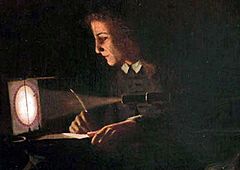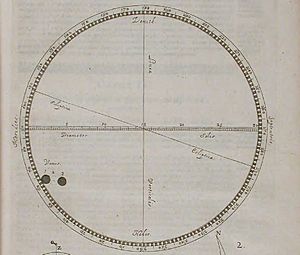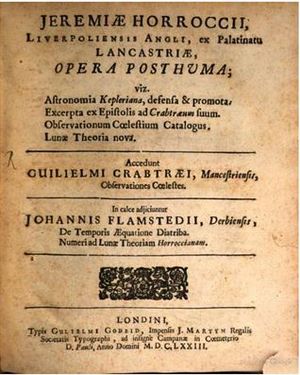Jeremiah Horrocks facts for kids
Quick facts for kids
Jeremiah Horrocks
|
|
|---|---|

Romanticised Victorian painting of Horrocks making the first observation of the transit of Venus in 1639. No contemporary portraits of Horrocks survive.
|
|
| Born | 1618 |
| Died | 3 January 1641 (aged 22) Toxteth Park, Liverpool, Lancashire, England
|
| Alma mater | University of Cambridge |
| Known for | Transit of Venus Tides Elliptical orbit Lunar orbit |
| Scientific career | |
| Fields | Astronomy Mathematics Mechanics |
Jeremiah Horrocks (1618–3 January 1641) was an English astronomer. He was the first person to show that the Moon moves around the Earth in an oval shape, called an elliptical orbit. He was also the only person to predict the transit of Venus of 1639. This was a rare event where Venus passes directly in front of the Sun. He and his friend William Crabtree were the only two people to see and record it.
Horrocks also correctly guessed that Jupiter was speeding up in its orbit. At the same time, Saturn was slowing down. He thought this was because of their gravity pulling on each other. This showed that gravity's pull wasn't just limited to the Earth, Sun, and Moon.
He died very young, at just 22 years old. The English Civil War also caused problems. Because of this, his important writings about the transit of Venus, called Venus in sole visa, were almost lost. But his work was saved. Today, he is known as one of the important founders of British astronomy.
Contents
Early Life and Studies
Jeremiah Horrocks was born at Lower Lodge Farm. This farm was in Toxteth Park, near Liverpool, England. His father, James, was a watchmaker. His mother, Mary, also came from a family of watchmakers. Both families were Puritans. This meant they had strong religious beliefs.
His family's work helped Jeremiah learn about astronomy early on. He helped set local clocks by measuring noon. His upbringing also made him doubt things like astrology and witchcraft.
In 1632, Horrocks started studying at Emmanuel College at the University of Cambridge. He was one of the few students there who believed in Copernicus's idea. This idea said that the Earth and planets orbit the Sun (the heliocentric theory). He studied the works of famous astronomers like Johannes Kepler and Tycho Brahe.
In 1635, Horrocks left Cambridge without finishing his degree. The exact reason is not clear. He might have needed to find a job to pay for his studies. Or he might have spent too much time on his own astronomy interests.
How He Studied the Stars
After leaving Cambridge, Horrocks decided to focus on astronomy. He started collecting books and tools for his studies. By 1638, he had the best telescope he could find.
Liverpool was a port city, so tools for navigation were easy to find. But special astronomy tools were not. So, Horrocks had to make his own. His father and uncles were watchmakers. They were skilled at making precise instruments. It seems he helped with the family business during the day. In return, his family helped him design and build tools to study the stars at night.
He owned a three-foot radius astronomicus. This was a tool used to measure angles between stars. By 1637, he needed a better tool. So, he built a larger, more accurate one. Even as a teenager, he read many astronomy books. He found their weak points and suggested new ways to research.
It is thought that Horrocks worked as a curate (a type of church assistant) in Much Hoole. This village is near Preston. But there is not much proof of this. Local stories say he lived at Carr House. He was probably a tutor for the children of the wealthy Stones family who lived there.
Discoveries About the Moon
Horrocks was the first to show that the Moon moves in an elliptical (oval) path around the Earth. He also thought that comets might follow elliptical paths too. He used a simple experiment to support his ideas. He noticed that a swinging weight, like a pendulum, also moved in an oval shape.
He also suggested that the Sun, not just the Earth, affects the Moon's orbit. This idea was later confirmed by Isaac Newton. Newton even mentioned Horrocks's work in his famous book, Principia. In his last months, Horrocks also studied tides. He tried to explain how the Moon causes the ocean's tides.
The Transit of Venus


In 1627, the astronomer Johannes Kepler published his "Rudolphine Tables." These tables helped predict the positions of planets. Two years later, Kepler warned astronomers about a transit of Mercury in 1631. He also mentioned transits of Venus in 1631 and 1761.
Horrocks had been watching Venus for years. He and his friend William Crabtree realized that Kepler's tables needed some changes. Kepler's tables predicted that Venus would almost miss the Sun in 1639. But Horrocks's own observations made him believe a transit would actually happen.
Horrocks made a simple tool called a helioscope. He used a telescope to project the Sun's image onto a flat surface. This allowed him to safely watch the Sun. From his home in Much Hoole, he calculated that the transit would start around 3:00 pm on November 24, 1639.
The weather was cloudy that day. But at about 3:15 pm, he saw the tiny black shadow of Venus crossing the Sun. He watched it for half an hour until the Sun set. William Crabtree also saw the transit from his home near Manchester.
Horrocks's observations helped him guess the size of Venus. Before, people thought Venus was bigger and closer to Earth. He also estimated the distance between the Earth and the Sun. This distance is now called the astronomical unit (AU). His estimate was about 95 million kilometers (59 million miles). This was much more accurate than any previous guess, even though the true distance is 150 million kilometers.
Horrocks wrote a book about the transit called Venus in sole visa (Venus seen on the Sun). It was published later by a Polish astronomer named Johannes Hevelius. When it was shown to the Royal Society in 1662, about 20 years after he wrote it, it caused great excitement. The book showed Horrocks's excited and poetic side. It even included humorous comments and original poems. When he wrote about how rare Venus transits are, he said:
- " ...Thy return
- Posterity shall witness; years must roll
- Away, but then at length the splendid sight
- Again shall greet our distant children's eyes."
This was a time when astronomers often disagreed. Some religious leaders also spoke against ideas that seemed to go against the Bible. But Horrocks, even though he was a religious young man, strongly believed in scientific facts. He wrote:
It is wrong to hold the most noble Science of the Stars guilty of uncertainty on account of some people's uncertain observations. Through no fault of its own it suffers these complaints which arise from the uncertainty and error not of the celestial motions but of human observations . . . I do not consider that any imperfections in the motions of the stars have so far been detected, nor do I believe that they are ever to be found. Far be it from me to allow that God has created the heavenly bodies more imperfectly than man has observed them. – Jeremiah Horrocks
His Death
Horrocks returned to Toxteth Park in mid-1640. He died suddenly on January 3, 1641, at just 22 years old. The cause of his death is unknown. His friend Crabtree said, "What an incalculable loss!" People describe Horrocks as a link between Isaac Newton and earlier astronomers like Copernicus, Galileo, Brahe, and Kepler.
It is believed he was buried at Toxteth Unitarian Chapel. However, there is no clear proof of this.
Legacy
Jeremiah Horrocks is honored with a plaque in Westminster Abbey. A crater on the Moon, called Horrocks, is named after him. In 1859, a marble tablet and stained-glass windows were put in the Parish Church of St Michael in Much Hoole to remember him. Toxteth Unitarian Chapel also has a plaque for his achievements. Horrocks Avenue in Garston, Liverpool, is named after him too.
In 1927, the Jeremiah Horrocks Observatory was built in Moor Park, Preston.
The 2012 transit of Venus was celebrated at the church in Much Hoole. The event was broadcast live around the world by NASA.
Horrocks and the transit of Venus were also featured in an episode of the British TV show Lewis.
In 2023, a new play called Horrox was performed in Cambridge. It was about Horrocks's short life and his important discoveries.
Jeremiah Horrocks Institute
The Jeremiah Horrocks Institute for Astrophysics and Supercomputing was started in 1993. It is part of the University of Central Lancashire. In 2012, its name was changed to the Jeremiah Horrocks Institute for Mathematics, Physics, and Astronomy.
See also
 In Spanish: Jeremiah Horrocks para niños
In Spanish: Jeremiah Horrocks para niños


